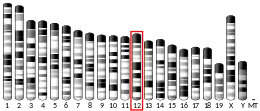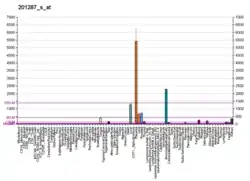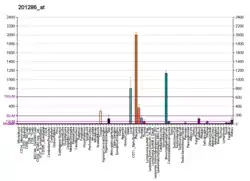Syndecan 1
Syndecan 1 is a protein which in humans is encoded by the SDC1 gene.[5][6] The protein is a transmembrane (type I) heparan sulfate proteoglycan and is a member of the syndecan proteoglycan family. The syndecan-1 protein functions as an integral membrane protein and participates in cell proliferation, cell migration and cell-matrix interactions via its receptor for extracellular matrix proteins. Syndecan-1 is a sponge for growth factors and chemokines,[7] with binding largely via heparan sulfate chains. The syndecans mediate cell binding, cell signaling, and cytoskeletal organization and syndecan receptors are required for internalization of the HIV-1 tat protein.
Altered syndecan-1 expression has been detected in several different tumor types. Syndecan 1 can be a marker for plasma cells.
Structure
The syndecan-1 core protein consists of an extracellular domain which can be substituted with heparan sulfate and chondroitin sulfate glycosaminoglycan chains, a highly conserved transmembrane domain, and a highly conserved cytoplasmic domain, which contains two constant regions that are separated by a variable region.[8] The extracellular domain can be cleaved (shed) from the cell surface at a juxtamembrane site,[9] converting the membrane-bound proteoglycan into a paracrine effector molecule with roles in wound repair [10] and invasive growth of cancer cells.[11]
An exception is the prosecretory mitogen lacritin that binds syndecan-1 only after heparanase modification.[12][13] Binding utilizes an enzyme-regulated 'off-on' switch in which active epithelial heparanase (HPSE) cleaves off heparan sulfate to expose a binding site in the N-terminal region of syndecan-1's core protein.[12] Three SDC1 elements are required. (1) The heparanase-exposed hydrophobic sequence GAGAL that promotes the alpha helicity of lacritin's C-terminal amphipathic alpha helix form and likely binds to the hydrophobic face. (2) Heparanase-cleaved heparan sulfate that is 3-O sulfated.[13] This likely interacts with the cationic face of lacritin's C-terminal amphipathic alpha helix. (3) An N-terminal chondroitin sulfate chain that also likely binds to the cationic face. Point mutagenesis of lacritin has narrowed the ligation site.[13]
While several transcript variants may exist for this gene, the full-length natures of only two have been described to date. These two represent the major variants of this gene and encode the same protein.[14]
Inflammation
Syndecan-1 deficient mice show increased inflammation, which was attributed to an increased ICAM-1 and heparan sulfate-dependent recruitment of leukocytes (including neutrophils and dendritic cells)[15] to the inflamed endothelium.[16] This increase results in higher inflammatory responses and tissue damage in experimental models of contact dermatitis,[17] inflammation of the kidney,[18] myocardial infarction,[19] inflammatory bowel disease[20] and experimental autoimmune encephalomyelitis[21] In experimental colitis-induced colon carcinoma, syndecan-1 deficiency promotes tumor growth in an IL-6 / STAT-signaling-dependent manner.[22]
Clinical significance
Altered syndecan-1 expression has been detected in several different tumor types.[23][24] In breast cancer, syndecan-1 is up regulated and contributes to the cancer stem cell phenotype, which is linked to increased resistance to chemotherapy and radiation therapy [25][26][27]
It is a specific antigen on multiple myeloma cells.[28] Indatuximab ravtansine targets this protein.
Application
It is a useful marker for plasma cells,[29] but only if the cells tested are already known to be derived from blood.[30] For plasma cells, it usually stains intensely membranous, with or without associated diffuse weak cytoplasmic and/or Golgi staining.[31] Few cases show cytoplasmic granular staining, with or without associated Golgi staining.[31]
References
- GRCh38: Ensembl release 89: ENSG00000115884 - Ensembl, May 2017
- GRCm38: Ensembl release 89: ENSMUSG00000020592 - Ensembl, May 2017
- "Human PubMed Reference:". National Center for Biotechnology Information, U.S. National Library of Medicine.
- "Mouse PubMed Reference:". National Center for Biotechnology Information, U.S. National Library of Medicine.
- Mali M, Jaakkola P, Arvilommi AM, Jalkanen M (April 1990). "Sequence of human syndecan indicates a novel gene family of integral membrane proteoglycans". The Journal of Biological Chemistry. 265 (12): 6884–6889. doi:10.1016/S0021-9258(19)39232-4. PMID 2324102.
- Ala-Kapee M, Nevanlinna H, Mali M, Jalkanen M, Schröder J (September 1990). "Localization of gene for human syndecan, an integral membrane proteoglycan and a matrix receptor, to chromosome 2". Somatic Cell and Molecular Genetics. 16 (5): 501–505. doi:10.1007/BF01233200. PMID 2173154. S2CID 43270934.
- Götte M (April 2003). "Syndecans in inflammation". FASEB Journal. 17 (6): 575–591. doi:10.1096/fj.02-0739rev. PMID 12665470. S2CID 16948257.
- Bernfield M, Götte M, Park PW, Reizes O, Fitzgerald ML, Lincecum J, Zako M (1999). "Functions of cell surface heparan sulfate proteoglycans". Annual Review of Biochemistry. 68: 729–777. doi:10.1146/annurev.biochem.68.1.729. PMID 10872465.
- Wang Z, Götte M, Bernfield M, Reizes O (September 2005). "Constitutive and accelerated shedding of murine syndecan-1 is mediated by cleavage of its core protein at a specific juxtamembrane site". Biochemistry. 44 (37): 12355–12361. doi:10.1021/bi050620i. PMC 2546870. PMID 16156648.
- Elenius V, Götte M, Reizes O, Elenius K, Bernfield M (October 2004). "Inhibition by the soluble syndecan-1 ectodomains delays wound repair in mice overexpressing syndecan-1". The Journal of Biological Chemistry. 279 (40): 41928–41935. doi:10.1074/jbc.M404506200. PMID 15220342.
- Piperigkou Z, Mohr B, Karamanos N, Götte M (September 2016). "Shed proteoglycans in tumor stroma". Cell and Tissue Research. 365 (3): 643–655. doi:10.1007/s00441-016-2452-4. PMID 27365088. S2CID 13944019.
- Ma P, Beck SL, Raab RW, McKown RL, Coffman GL, Utani A, et al. (September 2006). "Heparanase deglycanation of syndecan-1 is required for binding of the epithelial-restricted prosecretory mitogen lacritin". The Journal of Cell Biology. 174 (7): 1097–1106. doi:10.1083/jcb.200511134. PMC 1666580. PMID 16982797.
- Zhang Y, Wang N, Raab RW, McKown RL, Irwin JA, Kwon I, et al. (April 2013). "Targeting of heparanase-modified syndecan-1 by prosecretory mitogen lacritin requires conserved core GAGAL plus heparan and chondroitin sulfate as a novel hybrid binding site that enhances selectivity". The Journal of Biological Chemistry. 288 (17): 12090–12101. doi:10.1074/jbc.M112.422717. PMC 3636894. PMID 23504321.
- "Entrez Gene: SDC1 syndecan 1".
- Averbeck M, Kuhn S, Bühligen J, Götte M, Simon JC, Polte T (November 2017). "Syndecan-1 regulates dendritic cell migration in cutaneous hypersensitivity to haptens". Experimental Dermatology. 26 (11): 1060–1067. doi:10.1111/exd.13374. PMID 28453867. S2CID 38757296.
- Götte M, Joussen AM, Klein C, Andre P, Wagner DD, Hinkes MT, et al. (April 2002). "Role of syndecan-1 in leukocyte-endothelial interactions in the ocular vasculature". Investigative Ophthalmology & Visual Science. 43 (4): 1135–1141. PMID 11923257.
- Kharabi Masouleh B, Ten Dam GB, Wild MK, Seelige R, van der Vlag J, Rops AL, et al. (April 2009). "Role of the heparan sulfate proteoglycan syndecan-1 (CD138) in delayed-type hypersensitivity". Journal of Immunology. 182 (8): 4985–4993. doi:10.4049/jimmunol.0800574. PMID 19342678.
- Rops AL, Götte M, Baselmans MH, van den Hoven MJ, Steenbergen EJ, Lensen JF, et al. (November 2007). "Syndecan-1 deficiency aggravates anti-glomerular basement membrane nephritis". Kidney International. 72 (10): 1204–1215. doi:10.1038/sj.ki.5002514. PMID 17805240.
- Vanhoutte D, Schellings MW, Götte M, Swinnen M, Herias V, Wild MK, et al. (January 2007). "Increased expression of syndecan-1 protects against cardiac dilatation and dysfunction after myocardial infarction". Circulation. 115 (4): 475–482. doi:10.1161/CIRCULATIONAHA.106.644609. PMID 17242279.
- Floer M, Götte M, Wild MK, Heidemann J, Gassar ES, Domschke W, et al. (January 2010). "Enoxaparin improves the course of dextran sodium sulfate-induced colitis in syndecan-1-deficient mice". The American Journal of Pathology. 176 (1): 146–157. doi:10.2353/ajpath.2010.080639. PMC 2797877. PMID 20008145.
- Zhang X, Wu C, Song J, Götte M, Sorokin L (November 2013). "Syndecan-1, a cell surface proteoglycan, negatively regulates initial leukocyte recruitment to the brain across the choroid plexus in murine experimental autoimmune encephalomyelitis". Journal of Immunology. 191 (9): 4551–4561. doi:10.4049/jimmunol.1300931. PMID 24078687.
- Binder Gallimidi A, Nussbaum G, Hermano E, Weizman B, Meirovitz A, Vlodavsky I, et al. (2017). "Syndecan-1 deficiency promotes tumor growth in a murine model of colitis-induced colon carcinoma". PLOS ONE. 12 (3): e0174343. Bibcode:2017PLoSO..1274343B. doi:10.1371/journal.pone.0174343. PMC 5369774. PMID 28350804.
- Yip GW, Smollich M, Götte M (September 2006). "Therapeutic value of glycosaminoglycans in cancer". Molecular Cancer Therapeutics. 5 (9): 2139–2148. doi:10.1158/1535-7163.MCT-06-0082. PMID 16985046.
- Stepp MA, Pal-Ghosh S, Tadvalkar G, Pajoohesh-Ganji A (April 2015). "Syndecan-1 and Its Expanding List of Contacts". Advances in Wound Care. 4 (4): 235–249. doi:10.1089/wound.2014.0555. PMC 4397989. PMID 25945286.
- Hassan H, Greve B, Pavao MS, Kiesel L, Ibrahim SA, Götte M (May 2013). "Syndecan-1 modulates β-integrin-dependent and interleukin-6-dependent functions in breast cancer cell adhesion, migration, and resistance to irradiation". The FEBS Journal. 280 (10): 2216–2227. doi:10.1111/febs.12111. PMID 23289672. S2CID 19929711.
- Ibrahim SA, Gadalla R, El-Ghonaimy EA, Samir O, Mohamed HT, Hassan H, et al. (March 2017). "Syndecan-1 is a novel molecular marker for triple negative inflammatory breast cancer and modulates the cancer stem cell phenotype via the IL-6/STAT3, Notch and EGFR signaling pathways". Molecular Cancer. 16 (1): 57. doi:10.1186/s12943-017-0621-z. PMC 5341174. PMID 28270211.
- Götte M, Kersting C, Ruggiero M, Tio J, Tulusan AH, Kiesel L, Wülfing P (2006). "Predictive value of syndecan-1 expression for the response to neoadjuvant chemotherapy of primary breast cancer". Anticancer Research. 26 (1B): 621–627. PMID 16739330.
- Indatuximab Ravtansine (BT062) In Combination With Lenalidomide and Low-Dose Dexamethasone In Patients With Relapsed and/Or Refractory Multiple Myeloma: Clinical Activity In Len/Dex-Refractory Patients
- Rawstron AC (May 2006). "Chapter 6: Immunophenotyping of plasma cells". Current Protocols in Cytometry. Vol. Chapter 6. pp. Unit 6.23. doi:10.1002/0471142956.cy0623s36. ISBN 0471142956. PMID 18770841. S2CID 19511070.
- O'Connell FP, Pinkus JL, Pinkus GS (February 2004). "CD138 (syndecan-1), a plasma cell marker immunohistochemical profile in hematopoietic and nonhematopoietic neoplasms". American Journal of Clinical Pathology. 121 (2): 254–263. doi:10.1309/617D-WB5G-NFWX-HW4L. PMID 14983940.
- Al-Quran SZ, Yang L, Magill JM, Braylan RC, Douglas-Nikitin VK (December 2007). "Assessment of bone marrow plasma cell infiltrates in multiple myeloma: the added value of CD138 immunohistochemistry". Human Pathology. 38 (12): 1779–1787. doi:10.1016/j.humpath.2007.04.010. PMC 3419754. PMID 17714757.
Further reading
- David G (1992). "Structural and Functional Diversity of the Heparan Sulfate Proteoglycans". Heparin and Related Polysaccharides. Advances in Experimental Medicine and Biology. Vol. 313. pp. 69–78. doi:10.1007/978-1-4899-2444-5_7. ISBN 978-1-4899-2446-9. PMID 1442271.
- Jaakkola P, Jalkanen M (1999). Transcriptional regulation of Syndecan-1 expression by growth factors. Progress in Nucleic Acid Research and Molecular Biology. Vol. 63. pp. 109–38. doi:10.1016/S0079-6603(08)60721-7. ISBN 978-0-12-540063-3. PMID 10506830.
- Wijdenes J, Dore JM, Clement C, Vermot-Desroches C (2003). "CD138". Journal of Biological Regulators and Homeostatic Agents. 16 (2): 152–155. PMID 12144130.
- Lories V, Cassiman JJ, Van den Berghe H, David G (January 1992). "Differential expression of cell surface heparan sulfate proteoglycans in human mammary epithelial cells and lung fibroblasts". The Journal of Biological Chemistry. 267 (2): 1116–1122. doi:10.1016/S0021-9258(18)48404-9. PMID 1339431.
- Vainio S, Jalkanen M, Bernfield M, Saxén L (August 1992). "Transient expression of syndecan in mesenchymal cell aggregates of the embryonic kidney". Developmental Biology. 152 (2): 221–232. doi:10.1016/0012-1606(92)90130-9. PMID 1644217.
- Kiefer MC, Ishihara M, Swiedler SJ, Crawford K, Stephans JC, Barr PJ (1992). "The molecular biology of heparan sulfate fibroblast growth factor receptors". Annals of the New York Academy of Sciences. 638: 167–176. doi:10.1111/j.1749-6632.1991.tb49027.x. PMID 1664683. S2CID 29216939.
- Ala-Kapee M, Nevanlinna H, Mali M, Jalkanen M, Schröder J (September 1990). "Localization of gene for human syndecan, an integral membrane proteoglycan and a matrix receptor, to chromosome 2". Somatic Cell and Molecular Genetics. 16 (5): 501–505. doi:10.1007/BF01233200. PMID 2173154. S2CID 43270934.
- Mali M, Jaakkola P, Arvilommi AM, Jalkanen M (April 1990). "Sequence of human syndecan indicates a novel gene family of integral membrane proteoglycans". The Journal of Biological Chemistry. 265 (12): 6884–6889. doi:10.1016/S0021-9258(19)39232-4. PMID 2324102.
- Sanderson RD, Lalor P, Bernfield M (November 1989). "B lymphocytes express and lose syndecan at specific stages of differentiation". Cell Regulation. 1 (1): 27–35. doi:10.1091/mbc.1.1.27. PMC 361422. PMID 2519615.
- Asundi VK, Carey DJ (November 1995). "Self-association of N-syndecan (syndecan-3) core protein is mediated by a novel structural motif in the transmembrane domain and ectodomain flanking region". The Journal of Biological Chemistry. 270 (44): 26404–26410. doi:10.1074/jbc.270.44.26404. PMID 7592855.
- Zhang L, David G, Esko JD (November 1995). "Repetitive Ser-Gly sequences enhance heparan sulfate assembly in proteoglycans". The Journal of Biological Chemistry. 270 (45): 27127–27135. doi:10.1074/jbc.270.45.27127. PMID 7592967.
- Barillari G, Gendelman R, Gallo RC, Ensoli B (September 1993). "The Tat protein of human immunodeficiency virus type 1, a growth factor for AIDS Kaposi sarcoma and cytokine-activated vascular cells, induces adhesion of the same cell types by using integrin receptors recognizing the RGD amino acid sequence". Proceedings of the National Academy of Sciences of the United States of America. 90 (17): 7941–7945. Bibcode:1993PNAS...90.7941B. doi:10.1073/pnas.90.17.7941. PMC 47263. PMID 7690138.
- Spring J, Goldberger OA, Jenkins NA, Gilbert DJ, Copeland NG, Bernfield M (June 1994). "Mapping of the syndecan genes in the mouse: linkage with members of the myc gene family". Genomics. 21 (3): 597–601. doi:10.1006/geno.1994.1319. PMID 7959737.
- Sneed TB, Stanley DJ, Young LA, Sanderson RD (February 1994). "Interleukin-6 regulates expression of the syndecan-1 proteoglycan on B lymphoid cells". Cellular Immunology. 153 (2): 456–467. doi:10.1006/cimm.1994.1042. PMID 8118875.
- Maruyama K, Sugano S (January 1994). "Oligo-capping: a simple method to replace the cap structure of eukaryotic mRNAs with oligoribonucleotides". Gene. 138 (1–2): 171–174. doi:10.1016/0378-1119(94)90802-8. PMID 8125298.
- Kokenyesi R, Bernfield M (April 1994). "Core protein structure and sequence determine the site and presence of heparan sulfate and chondroitin sulfate on syndecan-1". The Journal of Biological Chemistry. 269 (16): 12304–12309. doi:10.1016/S0021-9258(17)32716-3. PMID 8163535.
- Albini A, Benelli R, Presta M, Rusnati M, Ziche M, Rubartelli A, et al. (January 1996). "HIV-tat protein is a heparin-binding angiogenic growth factor". Oncogene. 12 (2): 289–297. PMID 8570206.
- Bonaldo MF, Lennon G, Soares MB (September 1996). "Normalization and subtraction: two approaches to facilitate gene discovery". Genome Research. 6 (9): 791–806. doi:10.1101/gr.6.9.791. PMID 8889548.
- Kaukonen J, Alanen-Kurki L, Jalkanen M, Palotie A (March 1997). "The mapping and visual ordering of the human syndecan-1 and N-myc genes near the telomeric region of chromosome 2p". Human Genetics. 99 (3): 295–297. doi:10.1007/s004390050360. PMID 9050911. S2CID 30155082.





